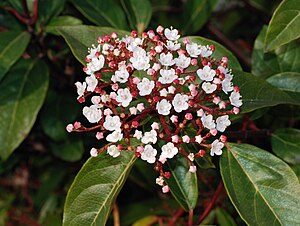Note: This is a project under development. The articles on this wiki are just being initiated and broadly incomplete. You can Help creating new pages.
Difference between revisions of "Viburnum tinus - Laurustinus viburnum"
(Created page with "thumb|right|''Viburnum tinus'', ''laurestine'' Viburnum tinus (Laurustinus, laurustinus viburnum, or laurestine) is a species of floweri...") |
(No difference)
|
Revision as of 10:32, 25 January 2017
Viburnum tinus (Laurustinus, laurustinus viburnum, or laurestine) is a species of flowering plant in the family Adoxaceae, native to the Mediterranean area of Europe and North Africa. Laurus signifies the leaves' similarities to bay laurel.
Description
It is a shrub (rarely a small tree) reaching 2–7 m (7–23 ft) tall and 3 m (10 ft) broad, with a dense, rounded crown. The leaves are evergreen, persisting 2–3 years, ovate to elliptic, borne in opposite pairs, 4–10 cm long and 2–4 cm broad, with an entire margin. The flowers are small, white or light pink, produced from reddish-pink buds in dense cymes 5–10 cm diameter in the winter. The fragrant flowers are bisexual and pentamerous. The flowering period is from October to June. Pollination is by insects. The fruit is a dark blue-black drupe 5–7 mm long.
Uses
V. tinus has medicinal properties. The active ingredients are viburnin (a substance or more probably a mixture of compounds) and tannins. Tannins can cause stomach upset. The leaves when infused have antipyretic properties. The fruits have been used as purgatives against constipation. The tincture has been used lately in herbal medicine as a remedy for depression. The plant also contains iridoid glucosides.
